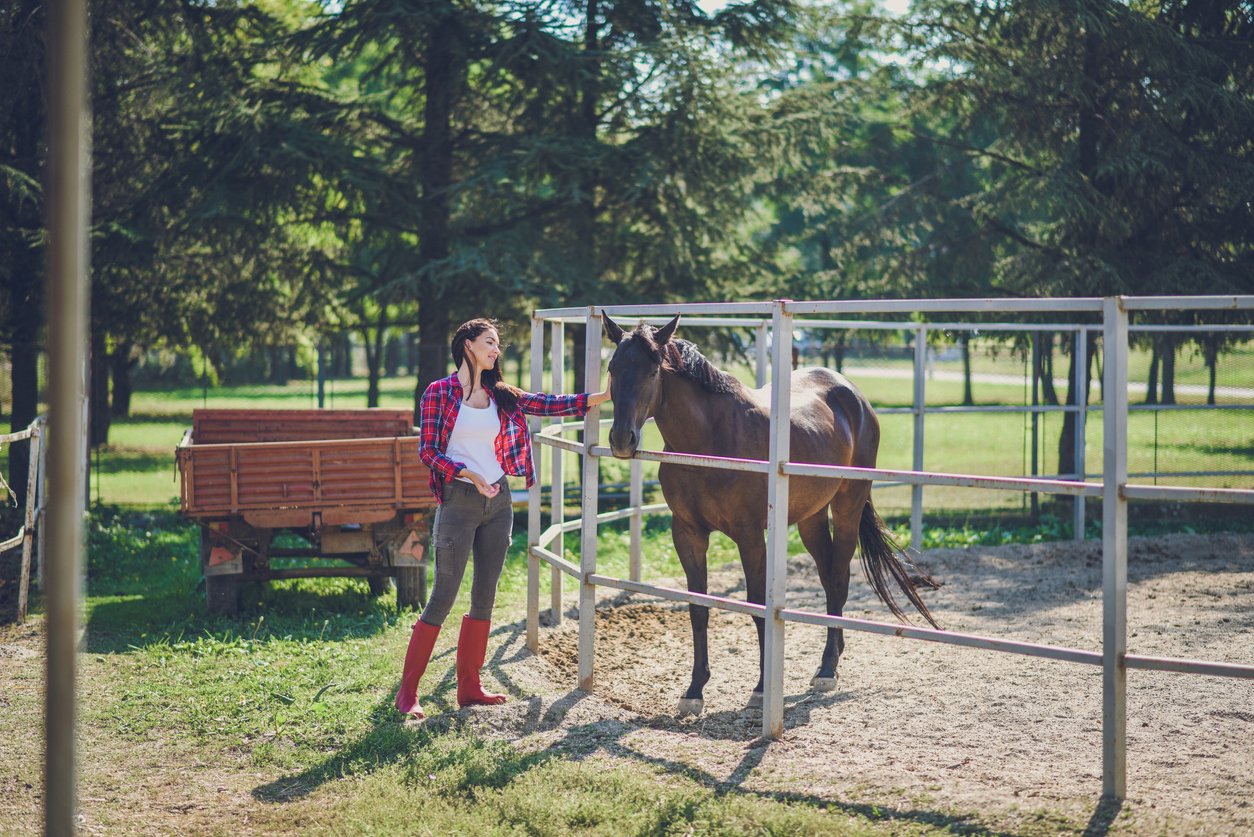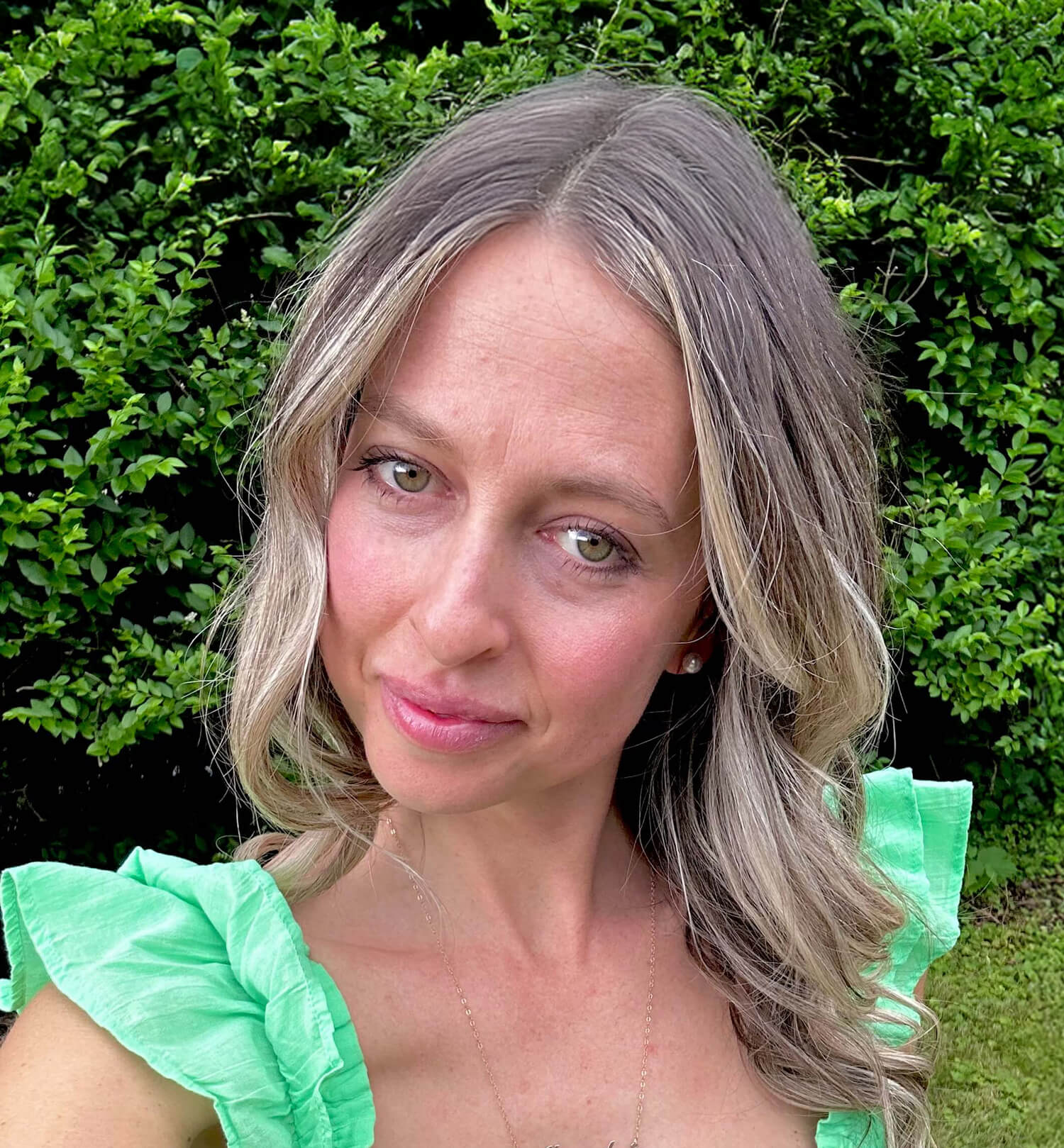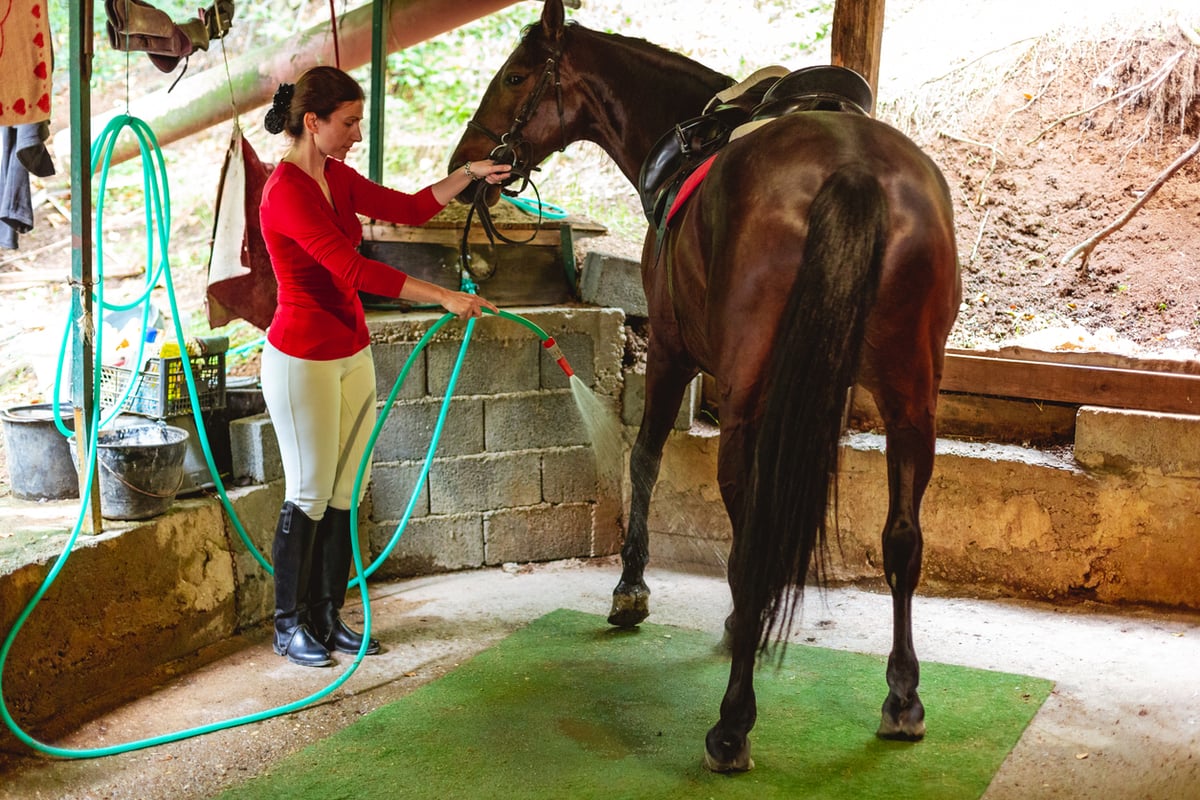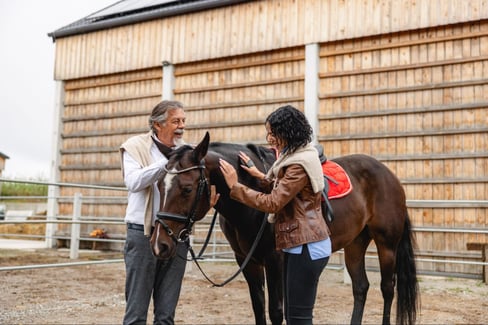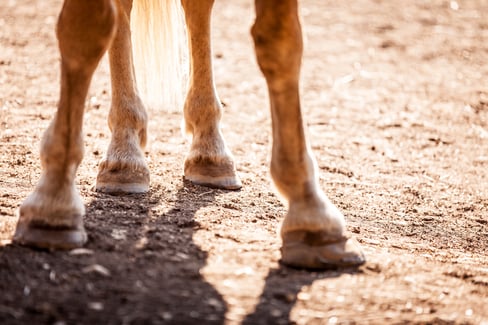Table of Contents
In a perfect world, everyone who owns a horse would always keep it on their own property. However, there are many different reasons why a horse owner would consider looking into a local horse stable.
Sometimes, horse owners live in an area without suitable land to keep a horse happy and healthy. Especially with increased property costs in many areas living on a property large enough to keep a horse can be difficult. Other times, time can be an issue regarding exercising, feeding, and maintaining a horse’s health, especially if it’s a performance or sport horse. In addition, if a horse owner goes on vacation or has other commitments they need to take care of, someone else must look after the horse while they are away.
A horse stable is an attractive and suitable option. A horse stable is more than just a space to keep your horse confined when you are away. Horse stables have staff that will exercise your horse, turn it out, feed it a balanced diet, and ensure that your horse's environment is clean and healthy. A good commercial stable knows that horses are free-range herd animals that need socialization and stimulating activities just as much as they need food and water and will work with your individual horse to ensure that their needs are met.
In other words, when it comes to your horse’s welfare, a good horse stable should follow the Five Freedoms and Five Domains—guidelines developed by animal welfare experts to ensure that an animal is getting what it needs to continue to be happy and healthy.
These freedoms and domains are listed below:
|
Five Freedoms |
Five Domains |
|
1. From hunger and thirst |
1. Nutrition |
|
2. From discomfort |
2. Environment |
|
3. From pain, injury, and disease |
3. Health |
|
4. To express normal behavior |
4. Behavioral interactions |
|
5. From fear and distress |
5. Mental state/experiences |
In this article, we explore the benefits of a horse stable and what horse owners should consider when selecting a horse stable to board their horse.
Common Types of Horse Stables
When looking for a horse stable in Canada or the United States, you’ll typically come across two distinct types of structures:
1. Traditional Barn Stabling
American barn stabling is where all horses are housed under one structure in individual stalls.
The pros and cons of barn stabling are explored in more detail in the following table:
|
Pros of Barn Stabling |
Cons of Barn Stabling |
|
|
2. Outdoor Board with Shelter
In outdoor boarding, horses are kept outside on a pasture and provided with an appropriate shelter (should be approximately 20 feet deep, with 12 feet of width for each horse).
The pros and cons of outdoor board stabling include:
|
Pros of Outdoor Board with Shelter |
Cons of Outdoor Board with Shelter |
|
|
Now that we’ve gone through the different structures that your horse would live in while they are being boarded, it’s important to explore the different boarding options that are available to you. Of course, you should visit any boarding facility you’re interested in and meet the owner and staff to see if a good first impression is made. As you can imagine, a good horseboarder will demonstrate empathy, compassion, and a strong personal affinity for the horses they care for.
Equine Boarding Options
There are three main types of boarding options for your equine:
1. Self-care
Self-care boarding is when the boarding facility provides the space and the structure to keep your horse, but you do everything for your horse, including providing feed and bedding (and of course feeding and cleaning your horse’s living space) and tending to daily care activities for your horse. In other words, with self-care, you’re renting the space without the services.
Because you’re responsible for the entirety of the care of your horse, self-care is the least expensive boarding option. Because you’ll need to make daily trips to the boarding facility, it’s important that it is located in close proximity to you and that you can dedicate the time to make the trip.
2. Partial boarding
Similar to self-care, partial boarding means that the responsibility of the horse’s care falls to the horse’s owner, but the equine boarder provides the bedding, feed, and hay. In many cases, the horse owner can negotiate with the equine boarder with regard to which duties each person performs.
3. Full boarding
With full boarding, everything needed to take care of a horse is done by the equine boarder and their staff. This includes feeding, cleaning, exercise, and more, depending on the horse’s needs. Depending on the complexity of care, the cost of full equine boarding can span a significant range. Performance or racing horses top the cost of full horseboarding because of their specific and demanding feeding and exercise needs.
Stall Boarding vs. Pasture Boarding
Some boarding facilities will only offer stall boarding (like the structures we discussed earlier) or pasture boarding (horse boarding outside). Just because a horse is provided with a stall in a boarding facility doesn’t necessarily mean that they will never get to see the outdoors, and similarly, if you use pasture boarding, that doesn’t mean your horse won’t have access to shelter.
- Stall boarding can vary significantly depending on the boarding facility and whether it offers self, partial, or full boarding options. It’s not uncommon for boarding facilities to not offer turnout, so if you want to exercise your horse, you have to go there and ride, lunge, or walk with your horse.
- Pasture boarding means that your horse lives outside on a pasture 24/7, often with other horses in a herd. While on the pasture, your horse usually has access to shelter, food, and water. The shelter will be in the form of trees or a constructed shelter that allows your horse (along with the others in the herd) to stand under it. It’s important to note that some pasture boarders will only provide hay to horses, while others will only offer self-care pasture boarding (so no direct food provided). Like stall boarding, some pasture boarding facilities will also offer full care services.
It’s best to get a full breakdown of the exact care that your horse will receive when you keep them at any facility so that you understand who is responsible for which care.
Retirement Horse Boarding
Just like humans, our equine friends sometimes have to retire from their careers due to age or illness. Horses also live longer than they used to because we are able to give them better care than we could in the past. The typical lifespan for a domestic horse is 20–30 years, but smaller breeds can sometimes live longer. Race horses usually only have a short career of 2–3 years, but they live just as long as a domestic horse.
Once a horse reaches their golden years or retires from their career, they must be cared for differently. A retirement horse boarding facility differentiates itself from a regular horse stable with staff expertise on the specific needs of older horses and horses with specific conditions and horse injuries.
If a horse passes away or needs to be euthanized, a retirement horse boarding service can usually provide options and additional care afterward, such as burial services or cremation, or direct the horse owner to someone who can provide these services if required.
Horse Riding Stable
A horse riding stable can have two different approaches to business:
- A boarding facility with the space to come and ride and otherwise interact with your horse at your leisure. If you’re an experienced rider who doesn’t need additional support, the horse riding stable will typically just allow you to use their facilities as part of the cost of boarding or for an additional fee.
- A facility that provides horse riding lessons in various disciplines, from simple horseback riding to dressage and racing. For horseback riding, the horse riding stable may offer their own horses for beginners or those who just want to ride a horse as a one-off event or allow people to bring in their own horses and use the facilities, equipment, and space. With dressage, racing, and other disciplines, a person would work with the horse riding stable to develop a consistent training regime for their horse.
If you’re boarding your horse with a facility that provides casual horseback riding to visitors, they will, of course, not use your equine for this purpose and instead provide their own horses.
Importance of Boarding Horse Stables
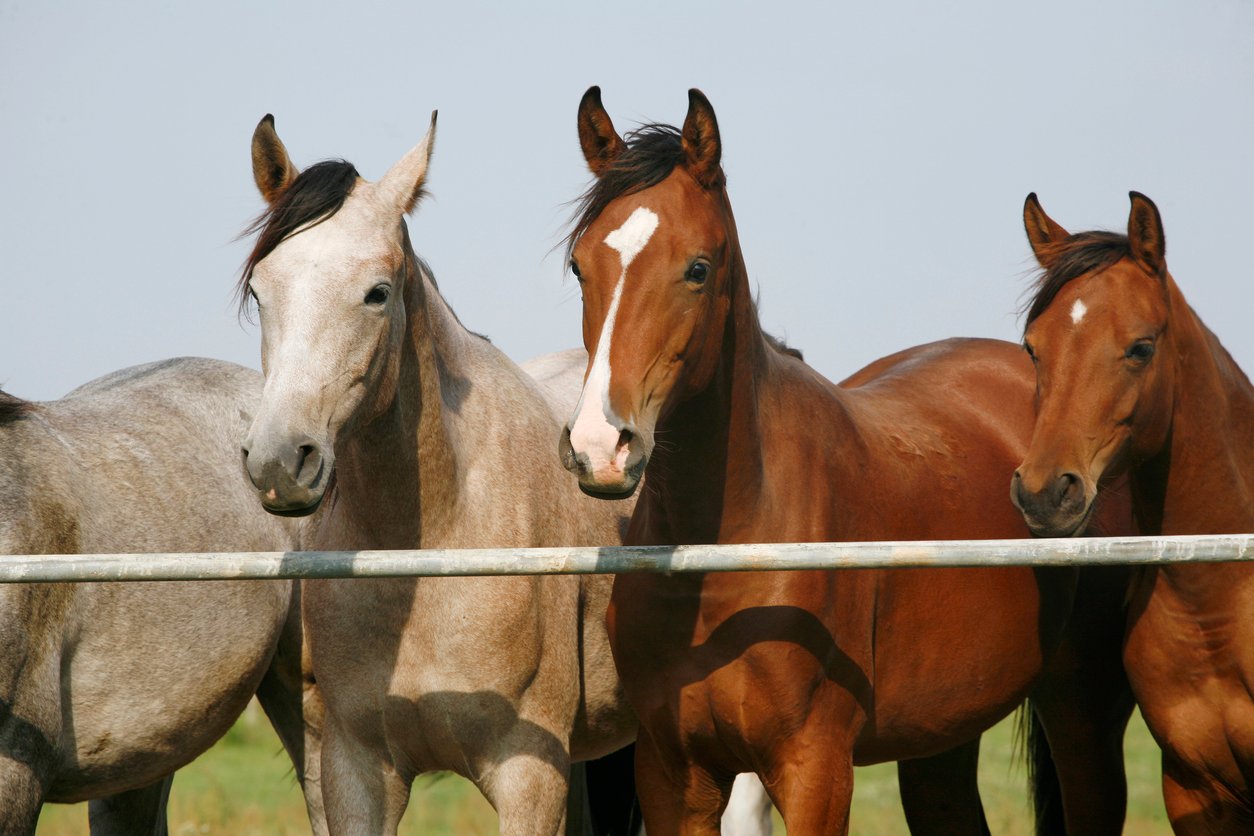
Boarding is a convenient and effective way to provide your horse with comprehensive care while you are away or are otherwise unable to look after your horse yourself. Horse boarding facilities range in the types of services they offer, so horse owners typically have a lot of choices when it comes to the amenities they would like their horses to have access to. Some boarding facilities provide horse boarding outside (pasture boarding), while others offer a stall or barn for your horse to stay in.
Other perks of using a horse boarding facility besides convenience and care while you are away include specialized care providers, various different facilities and equipment (e.g., longeing area, pastures, saddles, and more), as well as opportunities for socialization and exercise. Horses are herd animals, so giving your horse the opportunity to interact with other horses in a safe and controlled environment is essential for their mental health.
Benefits of a Horse Riding Stable
A Horse riding stable can provide many different benefits to horse owners, including:
1. Socialization
Horses are herd animals that need to socialize with other horses to maintain their mental and physical health. Being with other horses helps young horses develop essential social skills and learn how to establish relationships with other horses. They also learn how to communicate with each other and form lasting bonds.
Even adult horses benefit from playtime. Through play, a horse develops and conditions their bodies, builds coordination, and explores their environment. Play also relieves stress and frustration, which can build up and lead to bad behaviors if a horse is confined in a stall for too long. Horses that are not given ample opportunity to socialize can sometimes develop severe behavioral issues, such as anxiety, aggression, and repetitive behaviors like stall walking, cribbing, and weaving.
Boarding is a great way to give your horse the opportunity to interact with other horses in a safe environment. They may even develop a bond with another horse, leading to a new human friendship for you!
2. Access to Equine Experts
Some horse stables employ veterinarians, horse trainers, nutritionists, and other professionals to ensure that your horse gets the best care possible while at the facility. If you’re a beginner to horse ownership, boarding at a horse stable gives you the opportunity to learn about proper diet, exercise, socialization, and overall care for your horse.
In addition, if anything happens to your horse while it's boarded, the facility will have the means to react quickly to mitigate or treat any serious health issues.
3. Conditioning Opportunities
Regular exercise is extremely important for your horse. A boarding facility has the space and facilities (arenas, pastures, etc.) for your horse to roam around or ride comfortably.
For performance horses, a horse trainer can adapt different workout regimens and track your horse’s recovery time from exercise. Looking into horseboarding facilities is often a great way to find a competent trainer for your race or dressage horse.
Factors to Consider When Selecting a Horse Stable
Depending on where you live, there could be many choices for a horse stable or few. You’ll have to adjust your expectations accordingly depending on your situation, but there are some basic considerations to remember to ensure that the horse stable you choose can provide the right care for your horse.
Meet the Owners and Get a Facility Tour
The staff at the horse stable should be more than happy to give you a complete tour of the facility and show you exactly where your horse would be staying if you chose to go with their services. The more of the facility you can see, the better, as it will help you access the cleanliness and general upkeep of the facility.
Insurance Coverage
The horse owner and the horse stable owner should ensure they have the right insurance coverage for the horse in question. The below suggests insurance that a facility and horse owner should have in Canada:
- Liability insurance covers the property owner in case a rider gets injured or the horse causes damage to a third party (such as damaging a vehicle)
- Non-owned Livestock Liability Endorsement, or Care, Custody, and Control Insurance covers the property owner if a situation occurs where there is a physical injury that causes the horse’s death, where the property owner is proven to be negligent
- Horse owners who are members of their provincial federations usually have basic insurance coverage and even access to reduced prices for insurance
- Farm liability doesn’t cover a boarder’s horse, property such as tack and other personal items stored in a barn, or medical expenses, so the horse owner needs to ensure that they are properly covered
Feeding Program
Your horse’s nutrition is an extremely important consideration for where you board them if you are looking for a full or partial-service horse stable. Some important questions you can ask include:
- If in a multi-horse stable, are the horses separated during feeding time?
- How often do the horses get fed each day? Is there an option to have specific feeding times for an individual horse?
- What type of feed do the horses receive? (Remember that some pasture horse stables only provide hay to the horses)
- Do you perform hay analysis to ensure quality?
- Is hay or feed soaked if required (often done for horses suffering from laminitis, RAO, or HYPP)?
- How often is grain fed to the horses (if at all)?
- Where do you source the feed from? Are there choices for different types of feed?
- Is horse weight monitored?
- Is a nutritionist on staff?
- What is the watering system like, and how is it maintained (especially during winter)?
- Can the horse owner provide supplements of their choice to be included in the horse’s daily feedings? For example, if you provided TRI-ACTA to the stable to be fed to your horse, would they be willing to incorporate the supplement, according to the directions, into the horse feed?
- Who has created and been consulted to create a feeding and supplement program?
- Who does the daily feeding to ensure proper medication and supplements are administered?
Another important point to consider with feeding care is that with some full-service boarding facilities where, let’s say, your racehorse would be cared for, a trainer or other professional would choose supplements to be administered to all horses. In this case, additional questions you could ask include:
- Is there a supplement program in place?
- If a supplement is administered to horses in the stable’s care, which supplements are they?
- How often are horses fed supplements throughout the day?
Vet Care
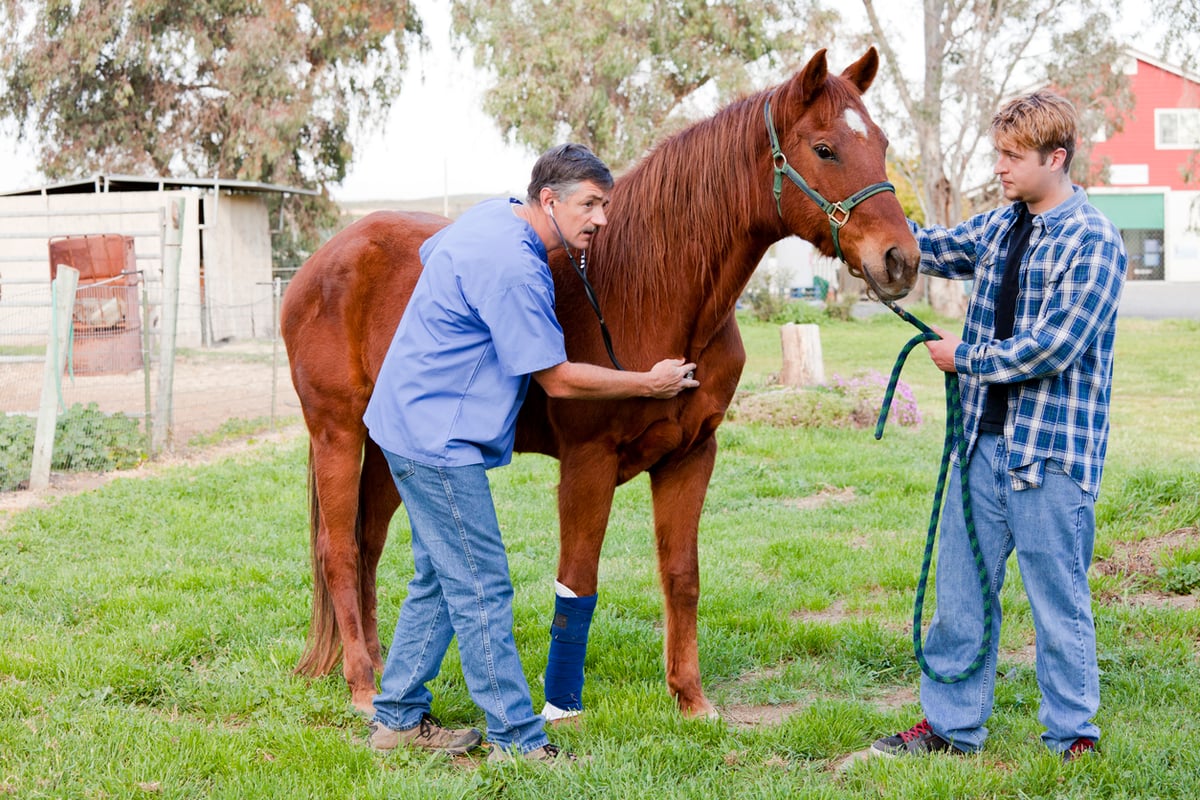
Providing the horse stable with detailed information on previous veterinary care that your horse has received and medical records is important to ensure continuity of care while they are boarded. In terms of questions you can ask the horse stable, here are some considerations:
- Availability of a veterinarian—is the veterinarian on call, there during business hours, only available on certain days, etc.?
- Can you bring in your own veterinarian if needed?
- If you must use the horse stable’s vet, what are the costs?
- What are the vaccination and deworming protocols?
- What care will be provided in the case of emergency, injury, or illness? (This will have to be discussed at the time of boarding)
- Is trailering available in case of emergency (e.g., wildfire)?
- What is included in first aid for my horse, or do I need to provide my own supplies?
- What is your blacksmith/farrier schedule, and who do you use?
- Can I bring in my own blacksmith/farrier?
Overall Service Offering
Different stables may offer different levels of service. As we mentioned earlier in this article, there are self-care, partial boarding, and full-boarding options. Some important questions to ask include:
- What level of services do you offer for horse care?
- What is included in each level of service? (e.g., for a full-service program, is feeding, supplements, training, grooming, and tacking up/cooling the horse included?)
- If a full-service program is offered, can I include my own supplements to be fed to my horse (e.g., TRI-ACTA)
TRI-ACTA H.A. for Equine
Our maximum strength formula is perfect for horses that are ageing, experiencing arthritis and stiffness, are in training and competition, or under a heavy workload.
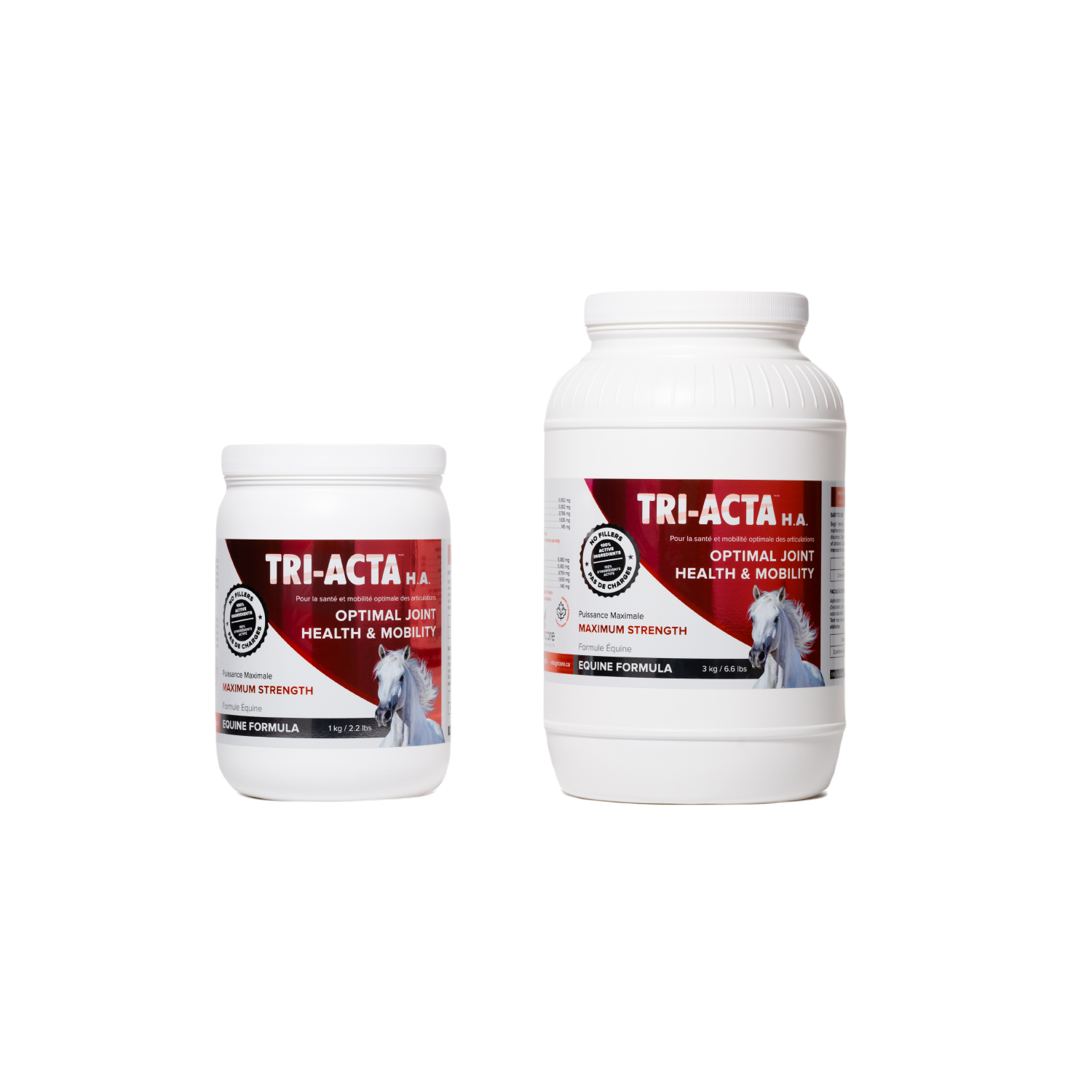
Cost
The overall cost of care while your horse is boarded is one of the most important considerations when choosing a stable horse. A good horse stable should provide a detailed cost breakdown for every type of service that will be provided to your horse, from costs of feeding and blanket changes to providing supplements. Some horse stables include access to certain facilities on the property, like arenas, trail access, and tack storage, while others require that the horse owner pay extra for these amenities.
As a general rule of thumb, the closer the horse stable is to a city, the higher the costs will be compared to a rural stable. Balance how much it costs in time and money to travel from a stable close to you to one further away, as even at a higher cost, a stable closer to you may be the better option.
Summary
When choosing a horse stable for your leisure or performance horse, there are many factors that you need to keep in mind.
First, the boarding option that you want:
- Self-care (you use the space but take care of your horse on your own)
- Partial boarding (care tasks are split up between the horse owner and the stable owner)
- Full boarding (complete care of the horse is provided by the stable owner)
From there, you need to decide whether stall boarding (where your horse is kept in a barn or stall) or pasture boarding (where your horse is kept outside at all times) is the better option for your horse.
Finally, feeding, socialization, insurance, access to veterinary care, exercise, and insurance need to be worked out between yourself and the stable owner.
Once you have everything lined up, it’s time to board your horse!
As horse owners, we want to keep our equine friends happy and healthy. One of the most important things you can do for your horse is give them joint supplements. Horse supplements like TRI-ACTA help maintain your horse’s joint health through a combination of 100% natural ingredients, including two types of glucosamine (sulfate and HCl, the sulfur in sulfate is essential to maintain joint tissue, while HCl helps your horse’s body absorb the glucosamine faster), chondroitin (helps maintain cartilage), Methylsulfonylmethane (MSM, a natural anti-inflammatory), and with our extra-strength version TRI-ACTA H.A., hyaluronic acid (increases the viscosity of synovial fluid in joints, allowing for easier movement).
The combination of therapeutic ingredients in TRI-ACTA ensures that your horse’s joint strength is maintained as they age, reducing the chances of serious injuries or conditions occurring.
TRI-ACTA H.A. for Equine
Our maximum strength formula is perfect for horses that are ageing, experiencing arthritis and stiffness, are in training and competition, or under a heavy workload.

Purchase TRI-ACTA online today, or learn where to buy at a store near you.
Newsletter Signup
Subscribe to our newsletter to receive the latest news and exclusive offers.
.jpg?height=2000&name=Cliick_Integricare-DISPLAY-REVISEDV2%20(1).jpg)
Proactive & Therapeutic Joint Supplements
When given daily, Integricare joint supplements recover bone and joint injuries faster and help prevent mobility injuries from happening in the first place.

